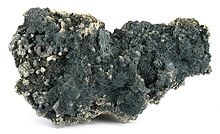This is the sandbox of Chris857. A sandbox is a subpage of a template or article used to test a change to the main article or template before deploying said changes. Once you have finished with the test, please erase the contents of this page leaving this box ({{Sandbox notice}}) in place. (diff) See also: Main sandbox
|
| Boulangerite | |
|---|---|
 Boulangerite, covering a block of limestone | |
| General | |
| Category | Sulfosalt mineral |
| Formula (repeating unit) | Pb5Sb4S11 |
| Strunz classification | 2.HC.15 |
| Dana classification | 3.5.2.1 |
| Crystal system | Monoclinic |
| Space group | H-M group: 2/m Space group: P21/a |
| Unit cell | a = 21.612(7) Å b = 23.543(8) Å c = 8.084(3) Å β = 100.71(2)°, Z=8[1] |
| Identification | |
| Color | Lead grey |
| Cleavage | Distinct on {100} |
| Tenacity | Brittle, flexible in thin crystals |
| Mohs scale hardness | 2.5–3 |
| Luster | Metallic, sometimes silky |
| Streak | Brownish |
| Diaphaneity | Opaque |
| Pleochroism | Weak |
| Ultraviolet fluorescence | Non-fluorescent[2] |
| References | [3] |
Boulangerite is a sulfosalt mineral with formula Pb5Sb4S11. The mineral was named in 1837 for Charles Louis Boulanger (1810–1849).
Description edit
Occurrence edit
Boulangerite occurs in association with arsenopyrite, galena, pyrite, quartz, siderite, sphalerite, stibnite, and various lead sulfosalts.[1]
Boulangerite has a very wide distribution; it is known from localities in North and South America, Europe, Africa, Asia, and Australia.[3][1]
History edit
In 1837, M. C. J. Thaulow named the mineral Boulangerit, in honor of French mining engineer Charles Louis Boulanger.[3][4] Boulanger analyzed a sample of the mineral from France and Thaulow analyzed material from Scandinavia (Lapland).[4]
When the IMA was founded, boulangerite was grandfathered as a valid mineral species.[3]
References edit
- ^ a b c Anthony, John W.; Bideaux, Richard A.; Bladh, Kenneth W.; Nichols, Monte C. (eds.). "Boulangerite" (PDF). Handbook of Mineralogy. Chantilly, VA: Mineralogical Society of America.
- ^ "Boulangerite". Webmineral. Retrieved April 1, 2013.
- ^ a b c d "Boulangerite". Mindat. Retrieved March 31, 2013.
- ^ a b Thaulow 1837, p. 221.
- Bibliography
- Thaulow, M. C. J. (1837). "Analyse eines antimonerzes vom Nasafjeld in Lapland" (PDF). Annalen der Physik und Chemie (in German). 41: 216–221.
External links edit
Media related to boulangerite at Wikimedia Commons
- http://rruff.info/uploads/The_American_Journal_of_Science_and_Arts95_1868_314.pdf
- http://rruff.info/uploads/AM3_39.pdf
- http://rruff.info/uploads/AM33_716.pdf
- http://rruff.info/uploads/AM45_1266.pdf
- http://www.minsocam.org/ammin/AM27/AM27_552.pdf
- http://canmin.geoscienceworld.org/content/50/2/219.figures-only
- http://www.minersoc.org/pages/Archive-MM/Volume_36/36-284-1174.pdf
- http://scripts.iucr.org/cgi-bin/paper?S0108270189008334
- http://www.canmin.org/content/50/2/181.full
- http://books.google.com/books?id=qOgvXBjecmQC&pg=PA504&lpg=PA504&dq=Boulangerite+plumosite&source=bl&ots=Yy5gT-R_Ra&sig=DN5vmlSvde8HggbNd8pkZnUf_nQ&hl=en&sa=X&ei=CITDUpTYGuGCyAGdpoHoCw&ved=0CEAQ6AEwBg#v=onepage&q=Boulangerite%20plumosite&f=false
- http://www.geo.edu.ro/sgr/mod/downloads/PDF/Cook-GeoCarp-1997.pdf (plumosite)
- http://eurjmin.geoscienceworld.org/content/13/2/411.figures-only
- https://books.google.com/books?id=4f3CUFYKEo8C&pg=RA8-PA591&lpg=RA8-PA591&dq=thaulow+boulangerite&source=bl&ots=9dSw01jfBo&sig=61h47E7PlCwEmOUH07N1RChgLJU&hl=en&sa=X&ved=0ahUKEwiKpvbLisDYAhUEOCYKHYX7B_oQ6AEIPDAG#v=onepage&q=thaulow%20boulangerite&f=false
- https://books.google.com/books?id=HddhAAAAcAAJ&pg=PA482&lpg=PA482&dq=thaulow+boulangerite&source=bl&ots=9rUwZLpVza&sig=IgK2qpeZQSLQPj3qxoWY_e2oWWA&hl=en&sa=X&ved=0ahUKEwiKpvbLisDYAhUEOCYKHYX7B_oQ6AEIQTAI#v=onepage&q=thaulow%20boulangerite&f=false